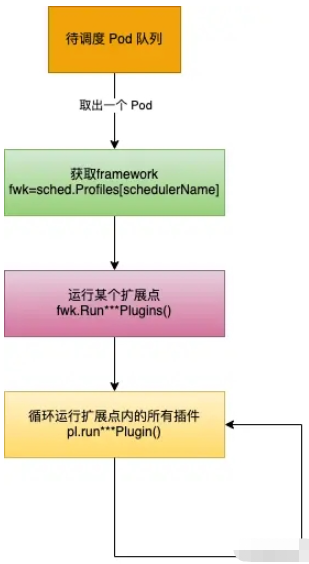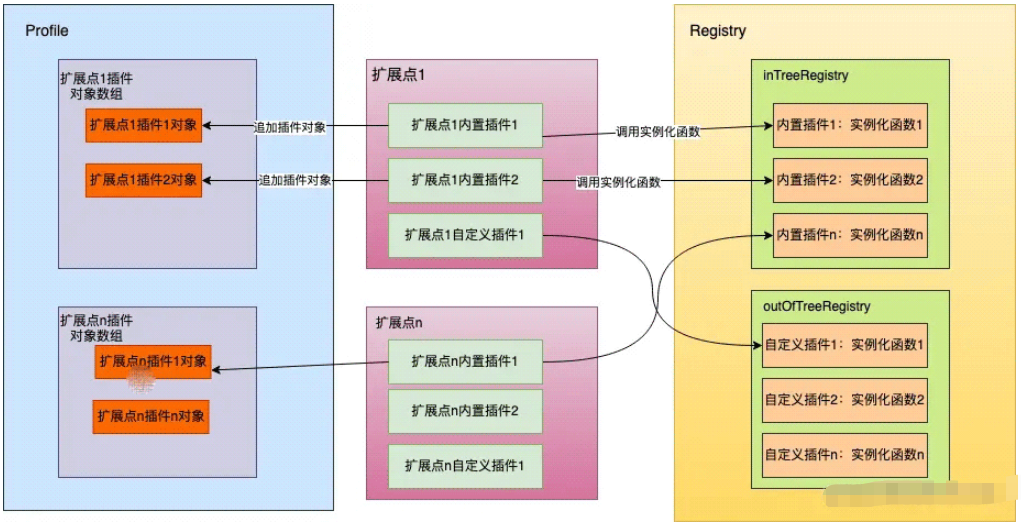Go语言kube-scheduler之scheduler初始化的方法是什么
来源:亿速云
时间:2023-05-03 19:13:49 399浏览 收藏
小伙伴们有没有觉得学习Golang很有意思?有意思就对了!今天就给大家带来《Go语言kube-scheduler之scheduler初始化的方法是什么》,以下内容将会涉及到scheduler、go语言、kube-scheduler,若是在学习中对其中部分知识点有疑问,或许看了本文就能帮到你!
今天小编给大家分享一下Go语言kube-scheduler之scheduler初始化的方法是什么的相关知识点,内容详细,逻辑清晰,相信大部分人都还太了解这方面的知识,所以分享这篇文章给大家参考一下,希望大家阅读完这篇文章后有所收获,下面我们一起来了解一下吧。
Scheduler之Profiles
下面我们先看下 Scheduler 的结构
type Scheduler struct {
Cache internalcache.Cache
Extenders []framework.Extender
NextPod func() *framework.QueuedPodInfo
FailureHandler FailureHandlerFn
SchedulePod func(ctx context.Context, fwk framework.Framework, state *framework.CycleState, pod *v1.Pod) (ScheduleResult, error)
StopEverything <p>为一个 Pod 选择一个 Node 是按照固定顺序运行扩展点的;在扩展点内,是按照插件注册的顺序运行插件,如下图</p><p><img src="/uploads/20230503/16831127306452431ae2fbb.png" alt="Go语言kube-scheduler之scheduler初始化的方法是什么"></p><p>上面的这些扩展点在 kube-scheduler 中是固定的,而且也不支持增加扩展点(实际上有这些扩展点已经足够了),而且扩展点顺序也是固定执行的。</p><p>下图是插件(以preFilter为例)运行的顺序,扩展点内的插件,你既可以调整插件的执行顺序(实际很少会修改默认的插件执行顺序),可以关闭某个内置插件,还可以增加自己开发的插件。</p><p><img src="/uploads/20230503/16831127316452431b37e8a.jpg" alt="Go语言kube-scheduler之scheduler初始化的方法是什么"></p><p>那么这些插件是怎么注册的,注册在哪里呢,自己开发的插件又是怎么加进去的呢?</p><p>我们来看下 Scheduler 里面最重要的一个成员:<strong>Profiles profile.Map</strong></p><pre class="brush:go;">// 路径:pkg/scheduler/profile/profile.go
// Map holds frameworks indexed by scheduler name.
type Map map[string]framework.FrameworkProfiles 是一个 key 为 scheduler name,value 是 framework.Framework 的map,表示根据 scheduler name 来获取 framework.Framework 类型的值,所以可以有多个scheduler。或许你在使用 k8s 的时候没有关注过 pod 或 deploment 里面的 scheduler,因为你没有指定的话,k8s 就会自动设置为默认的调度器,下图是 deployment 中未指定 schedulerName 被设置了默认调度器的一个deployment

假设现在我想要使用自己开发的一个名叫 my-scheduler-1 的调度器,这个调度器在 preFilter 扩展点中增加了 zoneLabel 插件,怎么做?
使用 kubeadm 部署的 k8s 集群,会在 /etc/kubernetes/manifests 目录下创建 kube-scheduler.yaml 文件,kubelet 会根据这个文件自动拉起来一个静态 Pod,一个 kube-scheduler pod就被创建了,而且这个 kube-scheduler 运行的参数是直接在命令行上指定的。
apiVersion: v1 kind: Pod metadata: creationTimestamp: null labels: component: kube-scheduler tier: control-plane name: kube-scheduler namespace: kube-system spec: containers: - command: - kube-scheduler - --address=0.0.0.0 - --authentication-kubeconfig=/etc/kubernetes/scheduler.conf - --authorization-kubeconfig=/etc/kubernetes/scheduler.conf - --bind-address=127.0.0.1 - --kubeconfig=/etc/kubernetes/scheduler.conf - --leader-elect=true image: k8s.gcr.io/kube-scheduler:v1.16.8 ....
其实 kube-scheduler 运行的时候可以指定配置文件,而不直接把参数写在启动命令上,如下形式。
./kube-scheduler --config /etc/kube-scheduler.conf
于是乎,我们就可以在配置文件中配置我们调度器的插件了
apiVersion: kubescheduler.config.k8s.io/v1beta2 kind: KubeSchedulerConfiguration leaderElection: leaderElect: true clientConnection: kubeconfig: "/etc/kubernetes/scheduler.conf" profiles: - schedulerName: my-scheduler plugins: preFilter: enabled: - name: zoneLabel disabled: - name: NodePorts
我们可以使用 enabled,disabled 开关来关闭或打开某个插件。 通过配置文件,还可以控制扩展点的调用顺序,规则如下:
如果某个扩展点没有配置对应的扩展,调度框架将使用默认插件中的扩展
如果为某个扩展点配置且激活了扩展,则调度框架将先调用默认插件的扩展,再调用配置中的扩展
默认插件的扩展始终被最先调用,然后按照 KubeSchedulerConfiguration 中扩展的激活 enabled 顺序逐个调用扩展点的扩展
可以先禁用默认插件的扩展,然后在 enabled 列表中的某个位置激活默认插件的扩展,这种做法可以改变默认插件的扩展被调用时的顺序
还可以添加多个调度器,在 deployment 等控制器中指定自己想要使用的调度器即可:
apiVersion: kubescheduler.config.k8s.io/v1beta2 kind: KubeSchedulerConfiguration leaderElection: leaderElect: true clientConnection: kubeconfig: "/etc/kubernetes/scheduler.conf" profiles: - schedulerName: my-scheduler-1 plugins: preFilter: enabled: - name: zoneLabel - schedulerName: my-scheduler-2 plugins: queueSort: enabled: - name: mySort
当然了,现在我们在配置文件中定义的 mySort,zoneLabel 这样的插件还不能使用,我们需要开发具体的插件注册进去,才能正常运行,后面的文章会详细讲。
好了,现在 Profiles 成员(一个map)已经包含了两个元素,{"my-scheduler-1": framework.Framework ,"my-scheduler-2": framework.Framework}。当一个 Pod 需要被调度的时候,kube-scheduler 会先取出 Pod 的 schedulerName 字段的值,然后通过 Profiles[schedulerName],拿到 framework.Framework 对象,进而使用这个对象开始调度,我们可以用下面这种张图总结下上面描述的各个对象的关系。

那么重点就来到了 framework.Framework ,下面是 framework.Framework 的定义:
// pkg/scheduler/framework/interface.go
type Framework interface {
Handle
QueueSortFunc() LessFunc
RunPreFilterPlugins(ctx context.Context, state *CycleState, pod *v1.Pod) (*PreFilterResult, *Status)
RunPostFilterPlugins(ctx context.Context, state *CycleState, pod *v1.Pod, filteredNodeStatusMap NodeToStatusMap) (*PostFilterResult, *Status)
RunPreBindPlugins(ctx context.Context, state *CycleState, pod *v1.Pod, nodeName string) *Status
RunPostBindPlugins(ctx context.Context, state *CycleState, pod *v1.Pod, nodeName string)
RunReservePluginsReserve(ctx context.Context, state *CycleState, pod *v1.Pod, nodeName string) *Status
RunReservePluginsUnreserve(ctx context.Context, state *CycleState, pod *v1.Pod, nodeName string)
RunPermitPlugins(ctx context.Context, state *CycleState, pod *v1.Pod, nodeName string) *Status
WaitOnPermit(ctx context.Context, pod *v1.Pod) *Status
RunBindPlugins(ctx context.Context, state *CycleState, pod *v1.Pod, nodeName string) *Status
HasFilterPlugins() bool
HasPostFilterPlugins() bool
HasScorePlugins() bool
ListPlugins() *config.Plugins
ProfileName() string
}Framework 是一个接口,需要实现的方法大部分形式为:Run***Plugins,也就是运行某个扩展点的插件,那么只要实现这个 Framework 接口就可以对 Pod 进行调度了。那么需要用户自己实现么?答案是不用,kube-scheduler 已经有一个该接口的实现:frameworkImpl
// pkg/scheduler/framework/runtime/framework.go
type frameworkImpl struct {
registry Registry
snapshotSharedLister framework.SharedLister
waitingPods *waitingPodsMap
scorePluginWeight map[string]int
queueSortPlugins []framework.QueueSortPlugin
preFilterPlugins []framework.PreFilterPlugin
filterPlugins []framework.FilterPlugin
postFilterPlugins []framework.PostFilterPlugin
preScorePlugins []framework.PreScorePlugin
scorePlugins []framework.ScorePlugin
reservePlugins []framework.ReservePlugin
preBindPlugins []framework.PreBindPlugin
bindPlugins []framework.BindPlugin
postBindPlugins []framework.PostBindPlugin
permitPlugins []framework.PermitPlugin
clientSet clientset.Interface
kubeConfig *restclient.Config
eventRecorder events.EventRecorder
informerFactory informers.SharedInformerFactory
metricsRecorder *metricsRecorder
profileName string
extenders []framework.Extender
framework.PodNominator
parallelizer parallelize.Parallelizer
}frameworkImpl 这个结构体里面包含了每个扩展点插件数组,所以某个扩展点要被执行的时候,只要遍历这个数组里面的所有插件,然后执行这些插件就可以了。我们看看 framework.FilterPlugin 是怎么定义的(其他的也类似):
type Plugin interface {
Name() string
}
type FilterPlugin interface {
Plugin
Filter(ctx context.Context, state *CycleState, pod *v1.Pod, nodeInfo *NodeInfo) *Status
}插件数组的类型是一个接口,那么某个插件只要实现了这个接口就可以被运行。实际上,我们前面说的那些默认插件,都实现了这个接口,在目录 pkg/scheduler/framework/plugins 目录下面包含了所有内置插件的实现,主要就是对上面说的这个插件接口的实现。我们可以简单用图描述下 Pod被调度的时候执行插件的流程

那么这些默认插件是怎么加到framework里面的,自定义插件又是怎么加进来的呢?
分三步:
根据配置文件(--config指定的)、系统默认的插件,按照扩展点生成需要被加载的插件数组(包括插件名字,权重信息),也就是初始化 KubeSchedulerConfiguration 中的 Profiles 成员。
type KubeSchedulerConfiguration struct {
metav1.TypeMeta
Parallelism int32
LeaderElection componentbaseconfig.LeaderElectionConfiguration
ClientConnection componentbaseconfig.ClientConnectionConfiguration
HealthzBindAddress string
MetricsBindAddress string
componentbaseconfig.DebuggingConfiguration
PercentageOfNodesToScore int32
PodInitialBackoffSeconds int64
PodMaxBackoffSeconds int64
Profiles []KubeSchedulerProfile
Extenders []Extender
}创建 registry 集合,这个集合内是每个插件实例化函数,也就是 插件名字->插件实例化函数的映射,通俗一点说就是告诉系统:1.我叫王二; 2. 你应该怎么把我创建出来。那么张三、李四、王五分别告诉系统怎么创建自己,就组成了这个集合。
type PluginFactory = func(configuration runtime.Object, f framework.Handle) (framework.Plugin, error) type Registry map[string]PluginFactory
这个集合是内置(叫inTree)默认的插件映射和用户自定义(outOfTree)的插件映射的并集,内置的映射通过下面函数创建:
// pkg/scheduler/framework/plugins/registry.go
func NewInTreeRegistry() runtime.Registry {
fts := plfeature.Features{
EnableReadWriteOncePod: feature.DefaultFeatureGate.Enabled(features.ReadWriteOncePod),
EnableVolumeCapacityPriority: feature.DefaultFeatureGate.Enabled(features.VolumeCapacityPriority),
EnableMinDomainsInPodTopologySpread: feature.DefaultFeatureGate.Enabled(features.MinDomainsInPodTopologySpread),
EnableNodeInclusionPolicyInPodTopologySpread: feature.DefaultFeatureGate.Enabled(features.NodeInclusionPolicyInPodTopologySpread),
}
return runtime.Registry{
selectorspread.Name: selectorspread.New,
imagelocality.Name: imagelocality.New,
tainttoleration.Name: tainttoleration.New,
nodename.Name: nodename.New,
nodeports.Name: nodeports.New,
nodeaffinity.Name: nodeaffinity.New,
podtopologyspread.Name: runtime.FactoryAdapter(fts, podtopologyspread.New),
nodeunschedulable.Name: nodeunschedulable.New,
noderesources.Name: runtime.FactoryAdapter(fts, noderesources.NewFit),
noderesources.BalancedAllocationName: runtime.FactoryAdapter(fts, noderesources.NewBalancedAllocation),
volumebinding.Name: runtime.FactoryAdapter(fts, volumebinding.New),
volumerestrictions.Name: runtime.FactoryAdapter(fts, volumerestrictions.New),
volumezone.Name: volumezone.New,
nodevolumelimits.CSIName: runtime.FactoryAdapter(fts, nodevolumelimits.NewCSI),
nodevolumelimits.EBSName: runtime.FactoryAdapter(fts, nodevolumelimits.NewEBS),
nodevolumelimits.GCEPDName: runtime.FactoryAdapter(fts, nodevolumelimits.NewGCEPD),
nodevolumelimits.AzureDiskName: runtime.FactoryAdapter(fts, nodevolumelimits.NewAzureDisk),
nodevolumelimits.CinderName: runtime.FactoryAdapter(fts, nodevolumelimits.NewCinder),
interpodaffinity.Name: interpodaffinity.New,
queuesort.Name: queuesort.New,
defaultbinder.Name: defaultbinder.New,
defaultpreemption.Name: runtime.FactoryAdapter(fts, defaultpreemption.New),
}
}那么用户自定义的插件怎么来的呢?这里咱们先不展开,在后面插件开发的时候再详细讲,不影响我们理解。我们假设用户自定义的也已经生成了 registry,下面的代码就是把他们合并在一起
// pkg/scheduler/scheduler.go
registry := frameworkplugins.NewInTreeRegistry()
if err := registry.Merge(options.frameworkOutOfTreeRegistry); err != nil {
return nil, err
}现在内置插件和系统默认插件的实例化函数映射已经创建好了
将(1)中每个扩展点的每个插件(就是插件名字)拿出来,去(2)的映射(map)中获取实例化函数,然后运行这个实例化函数,最后把这个实例化出来的插件(可以被运行的)追加到上面提到过的 frameworkImpl 中对应扩展点数组中,这样后面要运行某个扩展点插件的时候就可以遍历运行就可以了。我们可以把上述过程用下图表示

Scheduler 之 SchedulingQueue
上面我们介绍了 Scheduler 第一个关键成员 Profiles 的初始化和作用,下面我们来谈谈第二个关键成员:SchedulingQueue。
// pkg/scheduler/scheduler.go podQueue := internalqueue.NewSchedulingQueue( profiles[options.profiles[0].SchedulerName].QueueSortFunc(), informerFactory, // 1s internalqueue.WithPodInitialBackoffDuration(time.Duration(options.podInitialBackoffSeconds)*time.Second), // 10s internalqueue.WithPodMaxBackoffDuration(time.Duration(options.podMaxBackoffSeconds)*time.Second), internalqueue.WithPodNominator(nominator), internalqueue.WithClusterEventMap(clusterEventMap), // 5min internalqueue.WithPodMaxInUnschedulablePodsDuration(options.podMaxInUnschedulablePodsDuration), )
func NewSchedulingQueue(
lessFn framework.LessFunc,
informerFactory informers.SharedInformerFactory,
opts ...Option) SchedulingQueue {
return NewPriorityQueue(lessFn, informerFactory, opts...)
}type PriorityQueue struct {
framework.PodNominator
stop chan struct{}
clock clock.Clock
podInitialBackoffDuration time.Duration
podMaxBackoffDuration time.Duration
podMaxInUnschedulablePodsDuration time.Duration
lock sync.RWMutex
cond sync.Cond
activeQ *heap.Heap
podBackoffQ *heap.Heap
unschedulablePods *UnschedulablePods
schedulingCycle int64
moveRequestCycle int64
clusterEventMap map[framework.ClusterEvent]sets.String
closed bool
nsLister listersv1.NamespaceLister
}SchedulingQueue 是一个 internalqueue.SchedulingQueue 的接口类型,PriorityQueue 对这个接口进行了实现,创建 Scheduler 的时候 SchedulingQueue 会被 PriorityQueue 类型对象赋值。
PriorityQueue 中有关键的3个成员:activeQ、podBackoffQ、unschedulablePods。
activeQ 是一个优先队列,用来存放待调度的 Pod,Pod 按照优先级存放在队列中
podBackoffQ 用来存放异常的 Pod, 该队列里面的 Pod 会等待一定时间后被移动到 activeQ 里面重新被调度
unschedulablePods 中会存放调度失败的 Pod,它不是队列,而是使用 map 来存放的,这个 map 里面的 Pod 在一定条件下会被移动到 activeQ 或 podBackoffQ 中
PriorityQueue 还有两个方法:flushUnschedulablePodsLeftover 和 flushBackoffQCompleted
flushUnschedulablePodsLeftover:调度失败的 Pod 如果满足一定条件,这个函数会将这种 Pod 移动到 activeQ 或 podBackoffQ
flushBackoffQCompleted:运行异常的 Pod 等待时间完成后,flushBackoffQCompleted 将该 Pod 移动到 activeQ
Scheduler 在启动的时候,会创建2个协程来定期运行这两个函数
func (p *PriorityQueue) Run() {
go wait.Until(p.flushBackoffQCompleted, 1.0*time.Second, p.stop)
go wait.Until(p.flushUnschedulablePodsLeftover, 30*time.Second, p.stop)
}上面是定期对 Pod 在这些队列之间的转换,那么除了定期刷新的方式,还有下面情况也会触发队列转换:
有新节点加入集群
节点配置或状态发生变化
已经存在的 Pod 发生变化
集群内有Pod被删除
Scheduler 之 cache
要说 cache 最大的作用就是提升 Scheduler 的效率,降低 kube-apiserver(本质是 etcd)的压力,在调用各个插件计算的时候所需要的 Node 信息和其他 Pod 信息都缓存在本地,在需要使用的时候直接从缓存获取即可,而不需要调用 api 从 kube-apiserver 获取。cache 类型是 internalcache.Cache 的接口,cacheImpl 实现了这个接口。
下面是 cacheImpl 的结构
type Cache interface NodeCount() int PodCount() (int, error) AssumePod(pod *v1.Pod) error FinishBinding(pod *v1.Pod) error ForgetPod(pod *v1.Pod) error AddPod(pod *v1.Pod) error UpdatePod(oldPod, newPod *v1.Pod) error RemovePod(pod *v1.Pod) error GetPod(pod *v1.Pod) (*v1.Pod, error) IsAssumedPod(pod *v1.Pod) (bool, error) AddNode(node *v1.Node) *framework.NodeInfo UpdateNode(oldNode, newNode *v1.Node) *framework.NodeInfo RemoveNode(node *v1.Node) error UpdateSnapshot(nodeSnapshot *Snapshot) error Dump() *Dump }
type cacheImpl struct {
stop <p>cacheImpl 中的 nodes 存放集群内所有 Node 信息;podStates 存放所有 Pod 信息;,assumedPods 存放已经调度成功但是还没调用 kube-apiserver 的进行绑定的(也就是还没有执行 bind 插件)的Pod,需要这个缓存的原因也是为了提升调度效率,将绑定和调度分开,因为绑定需要调用 kube-apiserver,这是一个重操作会消耗比较多的时间,所以 Scheduler 乐观的假设调度已经成功,然后返回去调度其他 Pod,而这个 Pod 就会放入 assumedPods 中,并且也会放入到 podStates 中,后续其他 Pod 在进行调度的时候,这个 Pod 也会在插件的计算范围内(如亲和性), 然后会新起协程进行最后的绑定,要是最后绑定失败了,那么这个 Pod 的信息会从 assumedPods 和 podStates 移除,并且把这个 Pod 重新放入 activeQ 中,重新被调度。</p><p>Scheduler 在启动时首先会 list 一份全量的 Pod 和 Node 数据到上述的缓存中,后续通过 watch 的方式发现变化的 Node 和 Pod,然后将变化的 Node 或 Pod 更新到上述缓存中。</p><h3>Scheduler 之 NextPod 和 SchedulePod</h3><p>到了这里,调度框架 framework 和调度队列 SchedulingQueue 都已经创建出来了,现在是时候开始调度Pod了。</p><p>Scheduler 中有个成员 NextPod 会从 activeQ 队列中尝试获取一个待调度的 Pod,该函数在 SchedulePod 中被调用,如下:</p><pre class="brush:go;">// 启动 Scheduler
func (sched *Scheduler) Run(ctx context.Context) {
sched.SchedulingQueue.Run()
go wait.UntilWithContext(ctx, sched.scheduleOne, 0)
<p>NextPod 它被赋予如下函数:</p><pre class="brush:go;">// pkg/scheduler/internal/queue/scheduling_queue.go
func MakeNextPodFunc(queue SchedulingQueue) func() *framework.QueuedPodInfo {
return func() *framework.QueuedPodInfo {
podInfo, err := queue.Pop()
if err == nil {
klog.V(4).InfoS("About to try and schedule pod", "pod", klog.KObj(podInfo.Pod))
for plugin := range podInfo.UnschedulablePlugins {
metrics.UnschedulableReason(plugin, podInfo.Pod.Spec.SchedulerName).Dec()
}
return podInfo
}
klog.ErrorS(err, "Error while retrieving next pod from scheduling queue")
return nil
}
}Pop 会一直阻塞,直到 activeQ 长度大于0,然后去取出一个 Pod 返回
// pkg/scheduler/internal/queue/scheduling_queue.go
func (p *PriorityQueue) Pop() (*framework.QueuedPodInfo, error) {
p.lock.Lock()
defer p.lock.Unlock()
for p.activeQ.Len() == 0 {
// When the queue is empty, invocation of Pop() is blocked until new item is enqueued.
// When Close() is called, the p.closed is set and the condition is broadcast,
// which causes this loop to continue and return from the Pop().
if p.closed {
return nil, fmt.Errorf(queueClosed)
}
p.cond.Wait()
}
obj, err := p.activeQ.Pop()
if err != nil {
return nil, err
}
pInfo := obj.(*framework.QueuedPodInfo)
pInfo.Attempts++
p.schedulingCycle++
return pInfo, nil
}以上就是“Go语言kube-scheduler之scheduler初始化的方法是什么”这篇文章的所有内容,感谢各位的阅读!相信大家阅读完这篇文章都有很大的收获,小编每天都会为大家更新不同的知识,如果还想学习更多的知识,请关注golang学习网行业资讯频道。
今天带大家了解了scheduler、go语言、kube-scheduler的相关知识,希望对你有所帮助;关于Golang的技术知识我们会一点点深入介绍,欢迎大家关注golang学习网公众号,一起学习编程~
-
185 收藏
-
460 收藏
-
231 收藏
-
430 收藏
-
450 收藏
-
168 收藏
-
253 收藏
-
265 收藏
-
450 收藏
-
361 收藏
-
308 收藏
-
319 收藏
-
374 收藏
-
383 收藏
-
340 收藏
-
312 收藏
-
339 收藏
-

- 前端进阶之JavaScript设计模式
- 设计模式是开发人员在软件开发过程中面临一般问题时的解决方案,代表了最佳的实践。本课程的主打内容包括JS常见设计模式以及具体应用场景,打造一站式知识长龙服务,适合有JS基础的同学学习。
- 立即学习 543次学习
-

- GO语言核心编程课程
- 本课程采用真实案例,全面具体可落地,从理论到实践,一步一步将GO核心编程技术、编程思想、底层实现融会贯通,使学习者贴近时代脉搏,做IT互联网时代的弄潮儿。
- 立即学习 516次学习
-

- 简单聊聊mysql8与网络通信
- 如有问题加微信:Le-studyg;在课程中,我们将首先介绍MySQL8的新特性,包括性能优化、安全增强、新数据类型等,帮助学生快速熟悉MySQL8的最新功能。接着,我们将深入解析MySQL的网络通信机制,包括协议、连接管理、数据传输等,让
- 立即学习 500次学习
-

- JavaScript正则表达式基础与实战
- 在任何一门编程语言中,正则表达式,都是一项重要的知识,它提供了高效的字符串匹配与捕获机制,可以极大的简化程序设计。
- 立即学习 487次学习
-

- 从零制作响应式网站—Grid布局
- 本系列教程将展示从零制作一个假想的网络科技公司官网,分为导航,轮播,关于我们,成功案例,服务流程,团队介绍,数据部分,公司动态,底部信息等内容区块。网站整体采用CSSGrid布局,支持响应式,有流畅过渡和展现动画。
- 立即学习 485次学习
